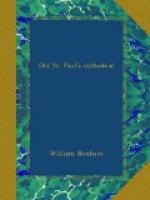At one of these Whitsun festivals (it was in 1327) another procession was held, no doubt to the delight of many spectators. A roguish baker had a hole made in his table with a door to it, which could be opened and shut at pleasure. When his customers brought dough to be baked he had a confederate under the table who craftily withdrew great pieces. He and some other roguish bakers were tried at the Guildhall, and ordered to be set in the pillory, in Cheapside, with lumps of dough round their necks, and there to remain till vespers at St. Paul’s were ended.
[Illustration: MONUMENT OF JOHN OF GAUNT AND BLANCHE OF LANCASTER. After W. Hollar.]
[Illustration: MONUMENT OF BISHOP ROGER NIGER. After W. Hollar.]
[Illustration: MONUMENT OF SIR JOHN BEAUCHAMP, POPULARLY KNOWN AS DUKE HUMPHREY’S. After W. Hollar.]
[Illustration: BRASS OF BISHOP BRAYBROOKE.]
[Illustration: BRASS OF JOHN MOLINS.]
[Illustration: BRASS OF RALPH DE HENGHAM.]
[Illustration: CHURCH OF ST. FAITH IN THE CRYPT OF ST. PAUL’S. After W. Hollar.]
We return to the religious history, in which we left off with the name of Wyclif. The Norman despotism of the Crown was crumbling away, so was the Latin despotism of the Church. On both sides there was evident change at hand, and Wiclif gave form to the new movement. He was born about 1324, educated at Oxford, where he won high distinction, not only by his learning, but by his holiness of life. The unparalleled ravages of the plague known as the “black death,” not only in England but




